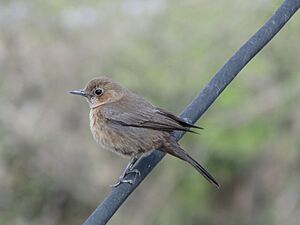Brown rock chat facts for kids
Quick facts for kids Brown rock chat |
|
|---|---|
 |
|
| Bateshwar Temples, Uttar Pradesh | |
| Conservation status | |
| Scientific classification | |
| Genus: |
Oenanthe
|
| Species: |
fusca
|
| Synonyms | |
|
Cercomela fusca |
|
The brown rock chat (Oenanthe fusca) is a cool bird found mostly in northern and central India. You can often spot it on old buildings or in rocky areas. It looks a bit like a female Indian robin, but it's bigger and doesn't have the reddish patch under its tail. When it flies, it might remind you of thrushes or redstarts. This bird mainly eats insects that it catches on the ground.
Contents
About the Brown Rock Chat
The brown rock chat was first described by a scientist named Edward Blyth in 1851. He gave it the name Saxicola fusca. For a long time, it was the only bird of its kind found outside of Africa.
Later, scientists studied the bird's DNA. They found that the brown rock chat is actually closely related to wheatears. Because of this, it was moved into the same group, or genus, as the wheatears. This group is called Oenanthe.
In some parts of central India, people call this bird Shama.
What it Looks Like
The brown rock chat is about 17 centimeters (about 7 inches) long. This makes it a bit larger than the Indian robin. It's mostly a uniform brown color. Its wings and tail are a little darker brown. The feathers under its tail are a dark grey-brown.
This bird has a thin beak that curves slightly at the tip. Its tail is rounded. When it flies, it can look a bit like a female blue rock thrush. It's hard to tell the difference between male and female brown rock chats just by looking at them.
Where it Lives
The brown rock chat lives almost entirely in India. You can find it north of the Narmada River, stretching west into Gujarat and east into Bengal. It also lives in the foothills of the Himalayas, up to about 1300 meters high. Its home also extends into northern Pakistan.
Most brown rock chats stay in one place. However, some might move around if the weather changes a lot. For example, in the Himalayas, they might move to higher places in summer and leave before winter starts. This bird is common, but you might only find it in certain spots.
You'll usually see these birds alone or in pairs. They like to hang out on old buildings or in rocky areas.
How it Behaves
What it Eats
Brown rock chats mainly eat insects. They usually pick their food right off the ground. Sometimes, they even eat insects that are attracted to lights at night.
When a brown rock chat is looking for food, it might quickly open its wings and tail. It also has a funny habit of slowly raising its tail a little, fanning it out, and bobbing its head.
What it Sounds Like
These birds have many different sounds! Scientists have noted almost eight different types of calls. These include calls for marking their territory, begging for food, warning others of danger, and even calls for when they are sleeping.
The most common sound is a short, whistled chee. They often make this sound while quickly bobbing their head and stretching. Their alarm call is a harsh chek-check.
The brown rock chat's song sounds a bit like a thrush. It has many different notes. It can even imitate the calls and songs of other birds, like the yellow-eyed babbler or the Tickell's blue flycatcher.
How it Raises Young
The brown rock chat's breeding season is from spring to summer. They can raise more than one group of babies in a year.
Their nest is shaped like a cup. It's made of grass, hair, and bits of mud. They usually build their nests in ledges on roadsides, walls, or even on windows of houses. Sometimes, they use small pebbles and clay to build the base of their nest.
The parent birds protect their nests very well. They will chase away animals like palm squirrels or other birds that come too close. A female brown rock chat usually lays three or four pale blue eggs. She sits on the eggs to keep them warm until they hatch. The young birds leave the nest about two weeks after they are born.



